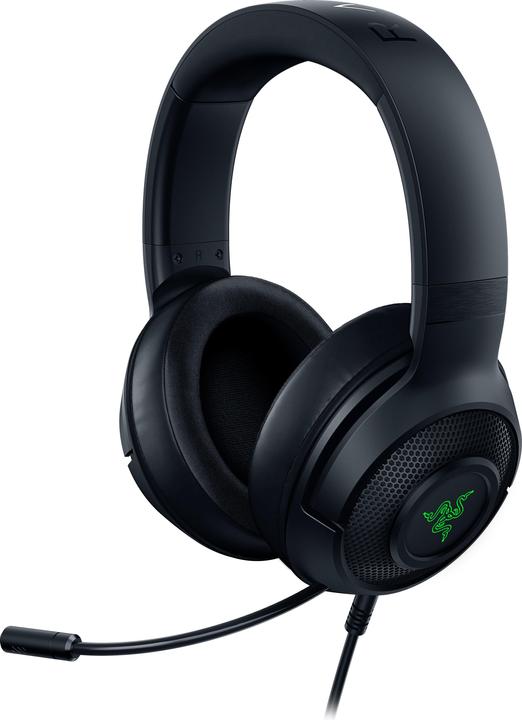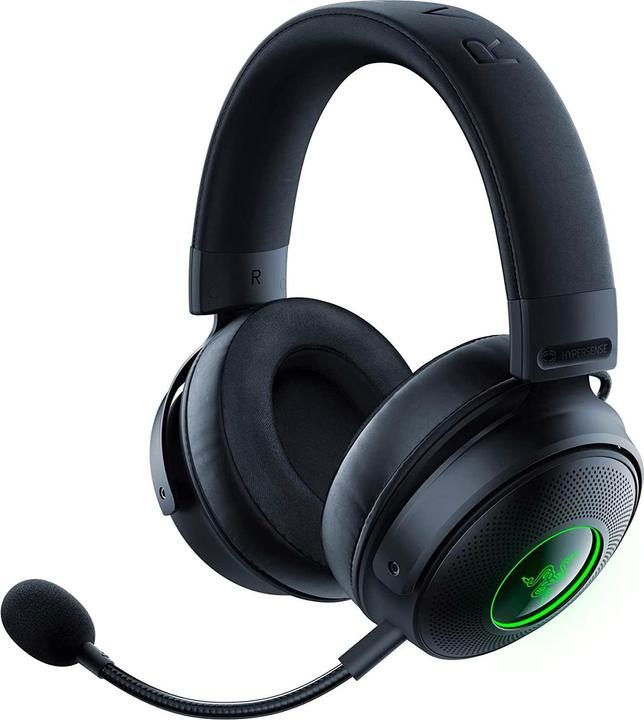

This kraken vibrates on your ears
Razer has kitted out the Kraken V3 with HyperSense technology, which makes the headset vibrate like your gaming controller. However, the special feature on this gaming headset – itself a solid option – hasn’t fully matured yet.
Boom! A grenade explodes somewhere to my left. I feel the powerful explosion on my left ear cup. The vibration radiates across my whole head. HyperSense is the name of Razer’s technology which makes your head tremble. It can be fun in some games, pamper you in virtual meetings and even treat you to a free head massage when you listen to bass-heavy songs. Apart from that, the Kraken V3 HyperSense also offers solid, full-bodied sound and a reasonable microphone.
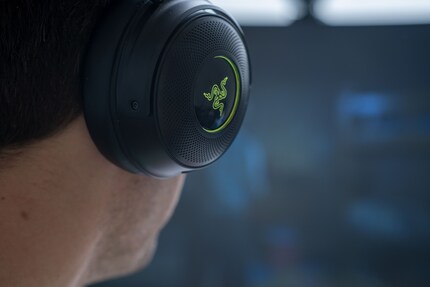
A spartan package
The box you receive contains nothing but the headset and the microphone. You attach the microphone to the left ear cup. It’s adjustable so you can move it to the perfect position. The two-metre coiled USB-A cable is a little stingy.

On the whole, the headset is well made. You can flex it in any direction to fit any head shape. The internal metal band has 16 different settings. It’s cushioned with memory foam and covered with artificial leather and fabric. To prevent excess sweating, the fabric is on the inside and the artificial leather on the outside so that your skin can breathe. The ear cups, which cover the whole ear, are similarly designed. I barely even feel the ear cups or headband after wearing them for hours, and they don’t make me sweat.

Visually, the Kraken V3 doesn’t look much different to other gaming headsets. It’s bulky and looks too big for my head, and only the RGB illuminated Razer logo on each ear cup deflects from the all-black look. The volume control wheel and the mute button for the microphone are on the back of the left ear cup. The right cup houses the HyperSense button that you use to set the feature to one of its three levels or switch it off.
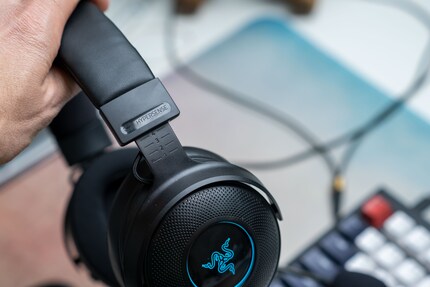
Aside from the Kraken V3 with HyperSense, there’s also the Kraken V3 and the Kraken V3 Pro with HyperSense and wireless.
HyperSense: no killer feature
In 1998, I was winding my way around the virtual tarmac on Gran Turismo with the first DualShock controller in my hand. What a feeling. The controller vibrated according to what happened on-screen and drew me into the game. Vibrating controllers have become standard, but vibration is still a killer feature today.
With HyperSense, Razer is looking to transfer the feeling from your hands to your head, which isn’t actually a stupid idea. If you’re gaming on your PC, you don’t want your mouse to vibrate. The movement affects your accuracy. I actually like this feature, at least for certain genres such as shooters or other action-packed games. It creates more immersion, drawing you further into the game.
However, the feature hasn’t fully matured yet. The software that creates the vibration relies on the bass, so it makes sense in action-packed games. If there’s a noise, it rumbles on your head, but it’d be out of place if you were playing a more sedate game. The software should be more sophisticated here – more specifically, the developers need to consciously implement the feature.
What’s more, the intensity can only be set to three levels – low, medium and high. It’s not enough. For me, the intensity is too low on low and medium, and too high on high. Stepless control in the software that you can save on the hardware switch would be great.
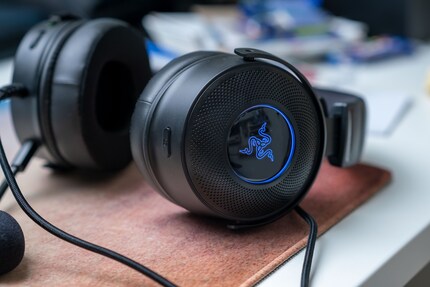
So, HyperSense can definitely make sense for games, but talking is another matter. If I’ve activated it on the highest level in virtual meetings, things get weird. The headset tap dances on my head if my male colleagues bombard me with their bass voices. At least I feel nice and relaxed after 20 minutes of a Kraken head massage, which isn’t something I can often say after meetings. Thankfully, HyperSense can be deactivated, so I can sit through meetings and listen to music without vibrations.
It’s even more striking with bass-heavy songs. When I listen to «Hip Hop» by Dead Prez, the Kraken nearly shakes right off my head. It’s fine for a massage, but listening to music becomes unbearable over time.
HyperSense is nice, but unlike DualShock for controllers, it’s not a feature that I absolutely have to have.
Solid sound
The Kraken V3 has 50mm drivers installed. The TriForce Titanium drivers, as Razer calls them, are already used in several of the manufacturer’s headsets. They deliver good sound quality, especially when it comes to the mids. However, the trebles are pretty weak. The nuances are missing – I can’t identify them. The low notes are OK, but the punch is missing from explosions. Thanks to HyperSense, I can feel that something is exploding, but I don’t hear it to the same extent. The headset is particularly weak when it comes to the lowest end of the spectrum.
I loved the surround sound with THX Spatial Audio. The 7.1 surround sound actually allows me to hear where my opponents are in games.
The microphone is totally fine for a gaming headset. Like the drivers, the mids are especially strong, so I can easily understand whoever I’m speaking too. However, the mic lacks substance on the low notes. I sound pretty flat. I can rectify that somewhat with the equaliser in the Razer Kraken software, but it still doesn’t sound great.
Software with plenty of settings to play with
I can adjust a raft of things under the Sound, Mixer, Enhancement, Mic and Lighting tabs in Razer’s Synapse software. The software has everything I want.

I activate the HyperSense volume and level under «Sound». I can also adjust the surround sound under «Mixer». «Enhancement» allows me to configure or even create the sound profile, and I can do the same for recording under «Mic». Finally, I can adjust the RGB effects on the ear cups under «Lighting».
Verdict: a good headset with a nice gimmick
HyperSense isn’t a killer feature, but it’s still nice. It’s fun to feel explosions and other elements in action-packed games.
Aside from HyperSense, the Kraken V3 is a well-made headset that doesn’t do much more than other gaming headsets. The sound is powerful, but it doesn’t blow me away. The low notes and trebles would have to be better balanced for that. The microphone is really strong in the mids, which is why my voice sounds flat, but that’s the case with most gaming headsets. In contrast, the surround sound is done well.
If you’re looking for a vibrating headset, I recommend the Kraken V3 HyperSense. Because it’s the only headset with vibration, it’s tricky to assess the price. The Kraken V3 without HyperSense costs just under 90 francs, placing it in the same price range as headsets of a similar quality. So, 40 more francs for the HyperSense version seems fair.
Personally, I prefer the combination of a podcast microphone and studio headphones on a digital to analogue converter (DAC) and amplifier. However, at 400 francs, my combo costs somewhat more than the Kraken V3 – and my Meze 99 Classics doesn’t vibrate.
From big data to big brother, Cyborgs to Sci-Fi. All aspects of technology and society fascinate me.
